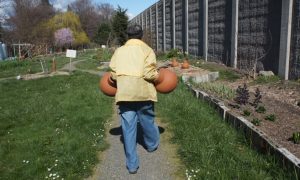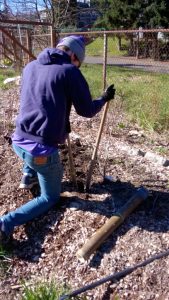Conclusions and Recommendations
This project helped us become more conscious of the how plants use water and how critical this resource is to our food supply. We now pay closer attention to individual plants’ varying needs for water, what happens when they do not get enough and how the soil and method of delivery impacts how much water they are able to obtain. It took a lot of work but it was interesting and educational. We learned many new things and felt the effort was worthwhile. The signage helped us share this information with the public and kept us focused on what our goals were.
One goal was to increase the amount of rainwater we can collect at the site and use it to grow trees, shrubs, perennials and annual vegetables and flowers. We had hoped that the 4,000 gallons of cistern water would meet our water needs through the summer and until the rains returned in September or October. We did not make it and had to switch to City water at the end of August. Since we don’t know if next year will be another hot and dry spring and summer, we will need to increase how much we collect by adding another cistern or rain barrels if we want to try again to not use City water. Amending the soil in areas that did not hold water very well will help, but if we water the plants in the trial beds less, they will probably suffer. We definitely did not overwater these beds, as evidenced by soil core samples.
We were lucky to find a treadle pump. Without it, we would have had to try to build one or find something comparable that could work without electricity. This system can be easily adapted to using a garden hose to fill the barrels with City water if one wanted to build a similar system but not collect rainwater.
We know of at least one other garden in the Seattle area that would like to replicate parts of our system. Anyone should also be mindful that elevating heavy barrels five feet in the air may pose a risk to people and plants below so the structures must be sturdy and the barrels securely attached. If you want to measure the amount of water that you use, you need translucent water barrels, or be ready to have some other tracking method in place. It will be difficult to tell how much water you used from a barrel unless, when painting the barrel, you leave an unpainted vertical line for this purpose.
One of our goals was to assess which drip irrigation system worked best. We were satisfied with the systems we built in the E and L beds, but were disappointed with what went into the A bed. It was worth the extra cost of soaker drip lines or take apart emitters and quality filters. Once the systems were installed, it was easy to turn them on and let them run while doing other garden activities. It took more effort to fill the barrels and keep the filters clean but those tasks did not have to be done as frequently.
We plan to plant cover crops in the beds this fall. It will be easy to move the soaker drip lines out of the way so as not to accidentally damage them when cutting down the cover crops but we anticipate it will be trickier in the E bed. We may find that cutting down the cover crops and giving the roots enough time to decompose in the soil on their own before planting will be the best course of action.
Our site is open to the public day and night. Luckily we did not experience destructive vandalism, but we had to install locks on all water sources. Our systems are in beds that are raised a few feet off the ground and we think this might help prevent damage to the irrigation lines. Just after we completed installing the system in the L bed, we found a rock inside the cam lever coupling. When it happened again, Ruth fashioned small fabric bags to fit over the couplings so that it would be difficult for debris to get into the drip lines.
We now have a better idea of what we need to keep track of so we can continue assessing how well these systems work. The systems should not take much more time to maintain or require additional cost. We plan to continue using the drip irrigation systems we built for the E and L beds and retrofit the A bed to make it functional. We want to try olla irrigation with different types of plants. We will continue to make compost, amend the soil especially in areas where the soil is sandier, use mulches to help conserve moisture and opt for drought-tolerant ornamental plants, especially native plants when feasible. We hope others are inspired by what we have built and will find more ways to collect enough rainwater and use it to grow healthy plants that are able to produce food for the community and enhance public spaces. We invite your comments and questions. Please email us at freewayestatescommmunityorchard@gmail.com.
We want to thank our very dedicated ongoing volunteers who don’t take anything away with them other than the satisfaction of building community and improving a public right-of-way. Special thanks to helpers who put in more than 10 hours on this grant project: Mike Carney, Jeff Callard, Ken Yu, Kate Wellens, Max Menchaca, Luke Fisher, Meg Johnson, Renee Jackman, Jennifer Klamm and Nancy Helm.



